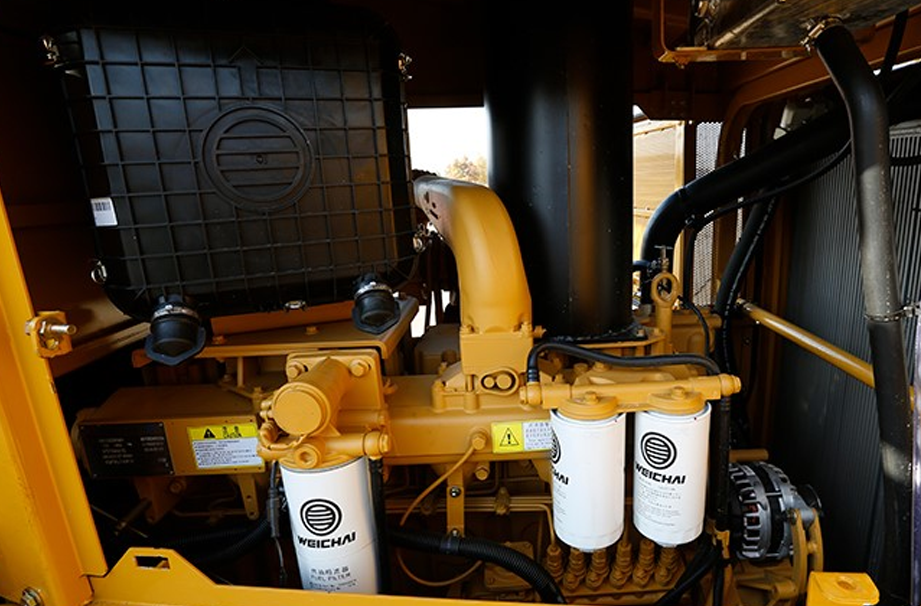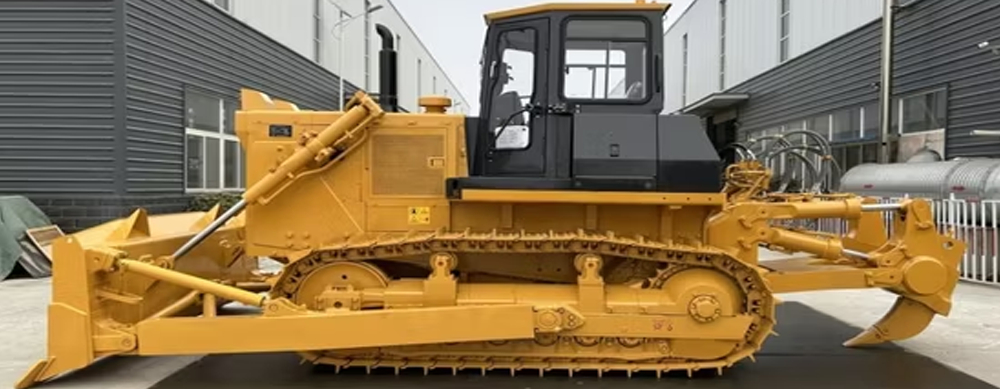Mining bulldozers are heavy-duty machines purpose-built for the extreme demands of mining operations. Engineered with robust frames and powerful diesel engines, they possess the strength to move vast quantities of earth, ore, and debris. Their large, reinforced blades can cut through tough materials and push heavy loads with ease. Equipped with advanced hydraulic systems, operators have precise control over blade movements. The undercarriage, typically with durable tracks, ensures excellent traction and stability on uneven mine terrains. Cabins are designed for operator comfort and safety, featuring good visibility and ergonomic controls, making them indispensable tools for efficient and productive mining work.
| Pictures |
|
|
|
|
|
| General parameters | |||||
| Model | D9R | D9T | D10T | D11T | D11T CD |
| Operating weight (kg) | 48784 | 47900 | 66451 | 104590 | 113000 |
| Engine | |||||
| Model | Cat 3408C | Cat® C18 ACERT™ | Cat® C27 ACERT™ | Cat® C32 ACERT™ | Cat® C32 ACERT™ |
| Flywheel power (kW) | 302 | 306 | 433 | 634 | 634 |
| Rated speed (r/min) | 1800 | ||||
| Total Displacement (L) | 18.1 | 27 | 32.1 | 32.1 | |
| Number of cylinders-(Bore×Stroke) (mm) | 137×152 | 145×183 | 137.2 ×152.4 | 145×162 | 145×162 |
| Dimension | |||||
| Overall length (mm) | 4919 | 4912 | 5339 | 10918 | 10918 |
| Overall width (mm) | 286 | 2865 | 3292 | 3160 | 3160 |
| Overall height (mm) | 3962 | 3980 | 4505 | 4543 | 4543 |
| Track plate width (mm) | 610 | 610 | 610 | 710 | 915 |
| Track Ground Length (mm) | 3474 | 3474 | 3885 | 4444 | 3855 |
| Minimum Ground Clearance (mm) | 591 | 596 | 615 | 675 | 615 |
| Hydraulic system | |||||
| Hydraulic pump type | Flywheel-driven piston pumps | Piston pumps with drive from the flywheel | Pinion (gear wheel) | Gear-type pumps | Gear-type pumps |
| Flow rate (at rated speed) (L/min) | 374 | 383 | 404 | 620 | 670 |
| Rated working pressure (Mpa) | 26200 | 26.2 | 18790 | 22750 | 24825 |
| Fuel volume | |||||
| Fuel tank capacity (L) | 908.4 | 889 | 1204 | 1609 | 1609 |
| Hydraulic oil tank capacity (L) | 77.2 | 89 | 144 | ||
| Engine oil (L) | 45.5 | 38 | 76 | 103 | 103 |
| Transmission system | |||||
| Travel speed 1st gear (forward/reverse) (km/h) | 3.9/4.8 | 3.9/4.7 | 4/5.2 | 3.9/4.7 | 3.9/4.7 |
| Travel speed 2nd gear (forward/reverse) (km/h) | 6.8/8.4 | 6.8/8.4 | 7.2/9 | 6.8/8.2 | 6.8/8.2 |
| Travel speed 3rd gear (forward/reverse) (km/h) | 11.9/14.7 | 11.7/14.3 | 12.7/15.8 | 11.8/14 | 11.8/14 |
| Shoveling device | |||||
| Type | 9SU | 9SU | 10SU | ||
| Shovel capacity (m³) | 13.5 | 13.5 | 18.5 | 46.3 | 46.3 |
| Spade Width (mm) | 4310 | 4310 | 4860 | 6706 | 6706 |
| Spade Height (mm) | 1934 | 1934 | 2120 | ||
| Maximum cut depth (mm) | 606 | 606 | 674 | ||
| Ground Clearance (mm) | 1422 | 1422 | 1497 | 615 | 615 |
| Maximum tilt (mm) | 940 | 940 | 993 |

1. Structure and Material: The frame of a mining bulldozer is a robust and heavy-duty structure, typically made of high-strength steel. It is designed to withstand the extreme forces and stresses exerted during mining operations.
2. Design Considerations: The frame design takes into account factors such as weight distribution, balance, and the attachment points for other components.
3. Engine: Mining bulldozers are powered by large, high-horsepower diesel engines. These engines are designed to provide the necessary torque and power to move the heavy machine and push large amounts of material.
4. Blade: The blade is one of the most important components of a mining bulldozer. It is attached to the front of the machine and is used for pushing, grading, and leveling materials.
5. Tracks: The tracks of a mining bulldozer are wide and made of heavy-duty steel links or rubber pads. They provide excellent traction and stability on various terrains, including soft ground, slopes, and rough surfaces.
6. Undercarriage: The undercarriage consists of components such as rollers, idlers, sprockets, and track tensioners. Rollers support the weight of the machine and help the tracks move smoothly.
7. Hydraulic System: The hydraulic system powers the movement of the blade, ripper, and other attachments. It consists of hydraulic pumps, cylinders, valves, and hoses.
8. Ripper: A ripper is a rear-mounted attachment on mining bulldozers. It is used to break up hard, compacted soil, rock, or frozen ground. The ripper consists of one or more shanks that can be forced into the ground using hydraulic power.

1. Determine the amount of power you need based on the mining operation's requirements. Mining bulldozers typically require high-horsepower engines to handle the heavy-duty work of pushing large volumes of earth and rock.
2. The size and design of the blade are crucial. A wider and deeper blade can move more material in a single pass. For large-scale mining projects, a U-shaped blade might be more suitable as it can handle larger volumes of loose material.
3. Inspect the frame construction. A heavy-duty, high-strength steel frame is essential to withstand the extreme forces and impacts in a mining environment. Look for features like reinforced joints and thick-walled components.
4. The width and length of the tracks affect the bulldozer's stability and traction. Wider tracks provide better stability, especially on slopes and uneven terrain, and distribute the machine's weight more evenly, reducing ground pressure.
5. The operator's cab should be comfortable and ergonomic. It should have an adjustable seat with good lumbar support to reduce operator fatigue during long shifts.
6. Choose a bulldozer that allows easy access to key components such as the engine, hydraulic system, and undercarriage. Easy access to these parts simplifies routine maintenance tasks such as oil changes, filter replacements, and inspections.
7. Look for bulldozers with roll-over protection structures (ROPS) and falling-object protection structures (FOPS). These safety features are essential to protect the operator in case of accidents such as the machine tipping over or objects falling on the cab.

High-Power Engines: Equipped with large-power engines, such as the Cummins X15-C525, capable of outputting hundreds or even thousands of horsepower. These engines meet the emission regulations of EU Stage V, US Tier 4, and China Stage IV, providing strong power for earth-moving, excavation, and clearance operations.
Advanced Transmission Technologies: Utilize hydrostatic transmission systems or other efficient transmission methods. For example, when a Cummins engine is paired with a Linde hydrostatic drive system, it offers rapid response and high transmission efficiency.
High-Strength Steel: The machine frame and key components are made of high-strength steel, possessing excellent impact resistance and load-bearing capacity.
Reinforced Chassis: The chassis structure is specially designed and strengthened to support the weight of the whole machine and the operating load.
Wear-Resistant Parts: Easily worn parts, such as the blade, tracks, and teeth, are made of wear-resistant materials or undergo special treatments.
Large-Capacity Blades: Fitted with wide and sturdy blades, available in different shapes and types, like semi-U-shaped and U-shaped blades.
